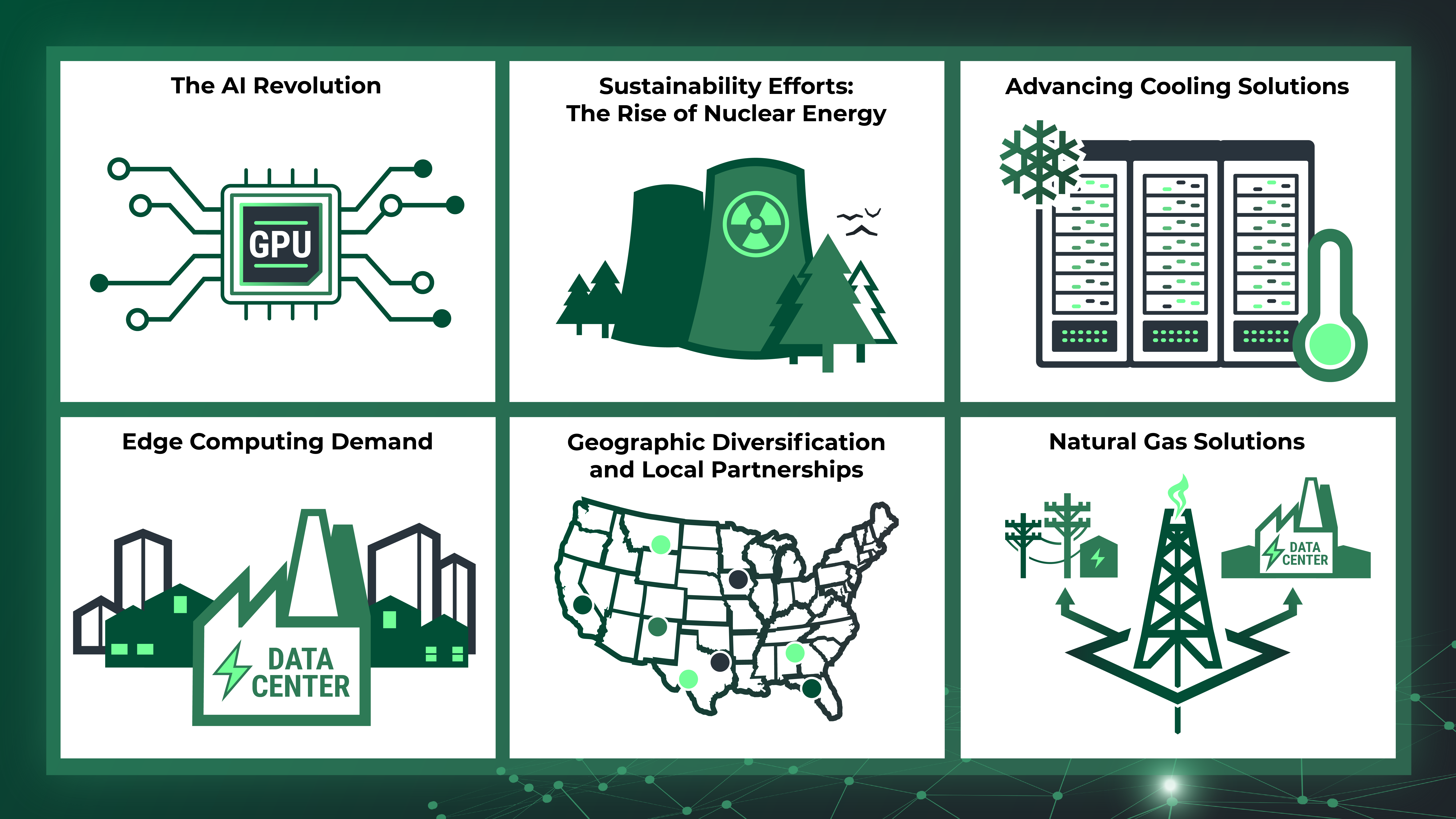In today’s hyper-connected world, data centers are the backbone of digital interactions. As technology rapidly evolves, 2025 is poised to be a transformative year for the industry. Emerging forces such as artificial intelligence, sustainability innovations, and the expansion of edge computing are redefining operational norms.
In this article, we’ll explore six key trends that are set to shape the industry in the coming year, and how Acres.com’s Data Center Index can help you stay ahead.
1. The AI Revolution
AI is no longer an emerging technology– but a driving force behind data center innovation. Machine learning and generative AI models require massive processing power, fueling demand for GPU-based servers and AI-optimized hardware.
As a result, operators are rethinking data center design to prioritize:
- High-density computing racks
- Optimized network architectures
- AI-driven automation
In 2025, expect AI not only to power client-facing applications but also to drive optimization of data centers internally— reducing energy use, predicting maintenance needs, and maximizing uptime.
2. Sustainability Efforts: The Rise of Nuclear Energy
Sustainability is essential. In response to regulatory pressure and corporate climate commitments, operators are adopting greener solutions, including:
- Increasing use of renewable energy sources like solar and wind
- Exploring nuclear energy as a reliable, zero-carbon power source
- Investing in advanced energy storage systems for grid stability
Nuclear energy, particularly small modular reactors (SMRs), is gaining traction for its ability to provide consistent, emissions-free power. It represents a scalable option for data centers aiming to reduce power consumption.
3. Advancing Cooling Solutions
Rising computing densities are pushing cooling capabilities to their limits. In 2025, advanced cooling methods are moving from niche to necessity.
Trends to watch for:
- Liquid cooling systems for targeted heat removal
- Immersion cooling, which submerges servers directly in cooling fluids
- AI-optimized airflow management to optimize performance and reduce waste
These solutions improve energy efficiency and reduce the overall environmental impact of data centers.
4. Edge Computing Demand
The surge in Internet of Things (IoT), 5G, and AI applications is driving demand for edge computing — bringing processing power closer to data sources.
In the coming year, expect to see:
- More micro data centers deployed in urban and rural settings
- Lower latency for real-time applications, from autonomous vehicles to telehealth
- Hybrid architectures blending cloud and edge solutions for flexibility
Edge computing brings computing power closer to end-users, improving speed and reliability while easing the load on central data centers.
5. Geographic Diversification and Local Partnerships
Global disruptions have highlighted the risks of centralized infrastructure. To strengthen resilience, data centers are:
- Expanding into new geographic regions
- Partnering with local utilities and municipalities
- Investing and developing in secondary and tertiary markets
This strategy helps optimize power procurement, reduce regulatory risk, and unlock new economic opportunities in underserved areas. Local partnerships are essential for aligning with community priorities.
6. Natural Gas Solutions
As grid bottlenecks and AI-driven demand strain energy infrastructure, natural gas is quickly emerging as a strategic power option for data centers. Natural gas solutions are gaining traction due to:
- Continuous Power: Natural gas generation ensures uninterrupted operation, safeguarding data centers from outages and data loss.
- Faster Deployment: Compared to traditional grid infrastructure, natural gas plants can typically be built and brought online more quickly (subject to permitting and approvals) allowing operators to meet demand faster.
- Scalability: Natural gas facilities can be tailored to meet a data center’s specific power needs, serving as either a primary source or a reliable backup.
- Reduced Grid Strain: On-site natural gas power generation eases dependence on local grids, freeing up capacity for other users and improving overall energy distribution.
Final Thoughts
The data center industry is evolving quickly. In 2025 and beyond, AI, sustainability initiatives, advanced cooling technologies, edge computing, and geographic diversification will lead the charge.
See how Acres.com can help you predict future business impact before new projects are publicly announced. Explore Acres’ Data Center Index to:
- Position your services in front of the right stakeholders early.
- Deploy technical teams and equipment before competition drives up costs.
- Invest in infrastructure (fiber, cooling, security, etc.) with real demand signals.
- Secure long-term partnerships by showing up before the RFP drops.
- Avoid wasting resources in markets that look promising but lack committed development.
Connect with our sales team today!
